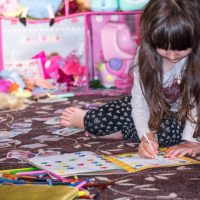“If you can dream it, you can do it”.
Walt Disney

Did you ever hear this saying?
This can certainly be TRUE for all of us, but for many parents of children with autism, improving communication for their non-verbal preschoolers can be a challenging journey…
The web is filled with information of all sorts …often times overwhelming …contradictory … leaving the families feel that increasing communication for their non-verbal preschoolers is out of their hands ….
…and in the hands of a therapist that can solve it all…
…or in many cases when this is not possible, because of the high costs, parents feel guilty or depressed ….
THE TRUTH IS that YOU CAN help your little one to greatly increase functional communication ….
Whether your preschool child has only a language delay or a condition such as autism, there is good news and does not require extra time or expenses…
This post will cover 11 most effective communication strategies that when incorporated daily in a non-verbal preschooler ‘s routines, will bring positive changes in both expressive and receptive language.
It has been widely demonstrated that developmental interventions embedded in our daily routines are the most successful model of Early Intervention for young children, especially for a child with special needs.
Mahoney and MacDonald(2007) estimated that caregiver and child interaction that occur just 1 hour every day, would include 220,000 learning opportunities every year compared with 30 minutes/week therapy session that would provide a child with just 7,500 learning opportunities /year
Why daily routines are so effective and meaningful for teaching communication and other skills?
Because they are naturally occurring events that are REPETITIVE, PREDICTABLE, FUNCTIONAL and represent meaningful contexts for children’s learning.
https://ectacenter.org/topics/families/famassess.asp
Every child is different and unique as well as his/her learning style.
From my experience working with many families of children with special needs, I see how hard and committed most families are to make good changes in their child’s learning; however, the best results happen to those who adopt the strategies they learn and believe in and practice them consistently….
REPETITION of proven EFFECTIVE STRATEGIES is the key to success in learning for all the children especially children with special needs
SIGN UP to receive Your FREE
Preschool Rewards Chart

Strategy 1: Get Face to Face
• your child needs to see your face, mouth, gestures; this will make communication easier and more effective
• it allows you to connect with your child and interact
Strategy 2: Speak clear, short,1-2 words sentences
•Make sure to get your child’s attention before speaking (e.g.: face to face, tactile cue such as a tap on the shoulder, call name…)
•Wait for the child to respond (up to 10-15 sec)
e.g: child playing with the cow ..label “cow, moo”..wait… if no response, then repeat and wait …. child says “mmmm”………acknowledge “yes…..moo”
Any attempt of copying a sound is a reason to praise.
Strategy 3: Use a child’s interests, motivation, as an opportunity for communication
•Make a list of all your child’s favourites: toys, food items, activities, routines all things that excite and motivate your child
• Remember that your child ‘s preferences may change day by day, so if it doesn’t work, then it may not be motivating for that time and you find something else more enticing.
Strategy 4: Teach Choice Making
Why choice making is important as a communication tool?
•Proving the child with an opportunity to make appropriate decisions during the day (“want apple or banana) will allow him/her to have control over a situation and become more confident in their ability to communicate
•Give a choice between two items or pictures, wait for his/her response (look, reach, point ), acknowledge “you chose apple”
With time this will become a more clear concept and will make clear choices.
Strategy 5: Teach “Give me” and other simple directions
I hear many parents say: “my child understands everything but doesn’t follow instructions…….does it sound familiar?
“Give me” is a basic 1 step direction that we can start teaching our children from very early on (around 1 year old)
•Many children with autism need to be taught this skill, it doesn’t come naturally.
• The key is to follow through with what you say e.g:” give me a cup” ….. wait for about 10 seconds for a response …if not responding, you can gently physically assist your child to let go ……acknowledge: “thank you –you gave me cup “
TIPS:
•When starting teaching this skill, best opportunities to practice are when your child is doing that action, anyway ….:e.g: when your child is done drinking, ask to GIVE before throwing or leaving the cup down …..and ALWAYS FOLLOW THROUGH with taking the item, even for a brief few seconds….being consistent they will learn faster and know that when you say “give” or bring” they are expected to do so .…
•When you ask your child to follow a simple, familiar direction and it doesn’t happen, do you sometimes stop asking and move forward on doing something else?
Or maybe, your child is selective in what instructions would follow?
e.g: he would bring me the TV remote to watch (because he loves watching his show ) but will not give me the cup when done drinking.
Did it ever happen to you? ….it surely happened to me, when my kids were younger…
Children quickly pick up on all our actions and behaviours and they act accordingly to our responses …so their inability to follow an instruction can become not only a communication issue but a behaviour one as well…
I encounter this situation in many cases while working with many families of children with autism and other conditions ….and because many of the kids are non-verbal or emerging language, is even more important to teach healthy behaviours and skills effectively; it will allow learning to occur instead of developing inappropriate behaviours.
Teaching this skill may take time and patience but if you show consistent behaviour such as prompting your child (minimal assistance that phases out in time) to perform the action when needed, it will be a faster process and more effective learning.
Strategy 6: Use FIRST/THEN strategy ( Premack Principle )
First /Then Strategy -is a well known visual ABA strategy that provides to the child information around an expectation, a routine or event in the day.
Why use FIRST/THEN?
•make transitions smoother /decrease behaviour problems as the child learns what’s next in his day (use as needed) e.g:” First bath then book time”
•increase motivation for completing an adult-directed task/activity
•helps a child to perform a non-favourite routine or task by having a reward afterwards FIRST “puzzle “THEN “firetruck “, when the firetruck is a child’s favourite
• increase independence,
•reduce verbal input provided to the child
You may use a First /Then visual board to increase understanding and learning
Strategy 7: Give “Less” so the child ask for “More”
E:G: When you give less of a favourite snack (a few tablespoons of cereal or just two slices of banana) you CREATE an OPPORTUNITY for your child to ASK for “MORE” .
If you give all the favourite snacks at once, there is no need for your child to LOOK, REACH, POINT…COMMUNICATE with you.
• You can practice this during favourite meal items or snacks, with favourite play activity e.g: car stickers, favourite people game e.g: tickle game or singing his/her favourite nursery rhyme.
•Give a little of the item and then WAIT for her/him to ask for MORE.
• Pair up the word “MORE” with a visual message such as the sign for “more” or a gesture.
Strategy 8: Place favourite things OUT OF REACH but ON SIGHT
This strategy may be a surprise for many parents.
Is it a surprise for you, too? Please share in comments some examples or thoughts…
Independence is a skill we want to teach children from early years …….. and is all correct ..BUT when you want to MOTIVATE your child to communicate, placing favourite things out of reach is a great way to promote communication.
If your child wants an item, WAIT until she/he does something to request it (gesture, pointing, lead hand, eye contact) …then you give it and label ”Juice “.
Strategy 9: Use visuals to aid in communication
We use visuals every day, all the time e.g: agenda, scheduler, calendar, grocery list……
There are many visual aids that can aid your child in the learning process and invite participation e.g: first /then board, visual schedule with pictures, flashcards, puzzle boards, storybooks……..
Children are visually wired
• 50% of children ‘s brain is involved in visual processing
•70% of all their sensory receptors are in their eyes
•More than 80% of people are visual learners
Strategy 10: Teach IMITATION skills
Read full information about this topic in my blog post ”“How to teach imitation to your non-verbal child with autism? Effective Communication strategies You need to know”
Imitation is a vital learning skill tool for all of us.
Many children with autism need to be taught this skill as it doesn’t come naturally and struggle with understanding abstract information, but they can successfully imitate the behaviour they are shown during their learning process.
What are some ways have you noticed your child imitating you? Please share it in the comments.
You can teach imitation of actions, gestures, sounds…..
How to teach imitation of actions?
Position yourself to your child’s level, face to face
Observe what your child is doing …then ..Copy your child s action
- If he is banging on the table with a block ….copy the action, use another block and bang on the table, too …wait for a response …if the child is responding by repeating the action that is a very nice back and forth game …
Next step you can become the leader and roll a car, tap a piano….wait for the child to copy ….if not, you may model hand over hand the action
- Actions to try (easy when incorporating in their favourite song):
-clap hands
-touch head, nose, eyes
-hands up
-wave hi/bye
Strategy 11: Observe what your child can say, give meaning and/or expand
If your child can say “mama” randomly, not in context, you want to give meaning as he/she says this word (an important one, too) .
Repeat acknowledge, say: “ mama” and gesture or point to yourself so he can associate the word with the person and in time use it functionally .
Conclusion
Whether we start by using 2, 3, or 7 of these evidence-based communication strategies, it is very important to use them consistently , on a daily basis.
How to make this possible when our schedules are so busy, so hectic at times?
It is possible, if we decide to embed these strategies in our daily routines because these are events that happen with consistency, they are functional and predictable …..and is demonstrated that children learn best during these times.
To find more information on what routines shall we choose, how to go about it , please read my post: “How to use Daily Routines to dramatically increase communication for your non-verbal preschooler”
Last but not least, when looking at maximizing learning for your child, is vital to understand the connection on how daily NUTRITION impacts HEALTH and LEARNING; many children with autism have a very limited repertoire of foods and are picky eaters. Therefore it is even more important to consider adding some of the powerful superfoods to boost your child’s health and learning e.g: Camu Camu, Moringa leaf …..read more in my blog posts Remarkable Superfoods you can try Today to boost your child’s health and learning- Camu Camu












